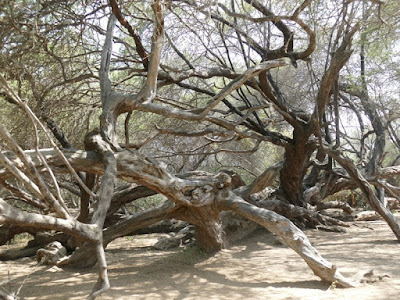The key focal points for most people's visit to Peru are either high in the Andes - Machu Picchu, Lake Titicaca, the cloud forests - or to the east in the Amazon basin, in the lowland rainforests. Quite right too. Nonetheless today I want to tell you about somewhere that is west of the Andes, not much above sea level (though nowhere near the sea) and very dry. And, I found, very special.
The Pomac Forest Historical Sanctuary is an area of just 6000 hectares of arid Algorrobo Prosopis pallida forest and open semi-desert, located 30km north of the major town of Chiclayo in far northern Peru. It was declared in 2001, to protect an important biodiverse and cultural landscape. The Tumbes eco-region of north-western Peru and adjacent Ecuador is an area of tropical dry forest, greatly reduced and fragmented, which supports unique and highly threatened wildlife. Birdlife International describes it as "one of the most important and threatened of all Endemic Bird Areas"; only 5% of the area remains forested, mostly degraded.
 |
| The end of the red arrow indicates Chiclayo, a city of nearly a million people, some 800km north of Lima. On this map, Pomac is pretty much on the outskirts. |
A key reason for its reservation was the presence of mighty mud brick pyramids - now softened at the edges to resemble vast piles of earth from a distance - which are tombs of the 'señors' of the pre-Inca Sicán culture, dating from 900-1200 years ago. When a 'señor' died he was buried under a pyramid - with wives and chief attendants, including chief priest and commander of his guard - then the entire pyramid was razed and another larger one built on top, starting with an extra perimeter base level.
 |
| Sicán pyramid (one of several), Pomac Forest, above and below. |
However I was there mostly for the natural values - though I certainly visited the remarkable Museum of the Royal Tombs of Sipán (a similar site nearby) on the edge of Chiclayo.
 |
| Museo de las Tumbes Reales de Sipán, Chiclayo. |
There are excellent walking tracks through the dense Algorrobo forest.
 |
| Algorrobo scrub, above and below. |
 |
| The Millenium Tree is an ancient Algorrobo tree; some estimates put it at over 1000 years old, though others are a little more modest. |
On the edge of the forest is even more arid open land, sand and rocky hillsides.
 |
| Sandy semi-desert with Prosopis spp. |
 |
| Cactus on rocky slopes. |
Back in the forest there are other plants in addition to the Algorrobo.
 |
| Mistletoe on Algorrobo. Amazilia Hummingbirds were feeding on the flowers, but I wasn't quick enough. |
 |
| Grabowskia buxifolia Family Solanaceae. This unlikely-looking tough foliage, along with the fruit, is an important food source for the endangered Tumbesian endemic Peruvian Plantcutter. |
 |
| Peruvian Plantcutter Phytotoma raimondii.After a long period of uncertainty the plantcutters are now regarded as cotingas. The Peruvian Plantcutter is known from just eight locations in northern Peru. |
Other endangered endemics present in Pomac include the Rufous Flycatcher Myiarchus semirufus and Tumbes Tyrant Tumbezia salvini. Not all residents are so rare however.
 |
| Long-tailed Mockingbirds Mimus longicaudatus are ubiquitous. |
 |
| Exquisite Vermilion Flycatchers Pyrocephalus rubinus are also common in the forest. |
 |
| Scarlet-backed Woodpecker Veniliornis callonotus - just about to touch down! |
 |
| Burrowing Owls Athene cunicularia are among the most widespread birds in the Americas. Around Pomac they can be seen perched out during the day, or at the mouth of their burrow. |
 |
| Savannah Hawks Buteogallus meridionalis live in the open country all around Pomac. |
 |
| Black Vultures Coragyps atratus hang around the pyramids, and perch on them (see large pyramid photo above). |
Northern Peru isn't on every visitor's itinerary, though I reckon it should be. And when you go there, definitely don't miss Pomac!
BACK ON TUESDAY



2 comments:
This place looks amazing. There seems to be something about it. The pyramids give tremendous atmosphere and the wildlife seems to be really different to anywhere else. I suppose it has impact because it is so different to the usual stuff you read about South America.
Agreed Susan, it is definitely special for all those reasons. And it is somewhat surreal to be in Australian- or African-type harsh arid scrubland in South America - it's not supposed to be like that!
Post a Comment